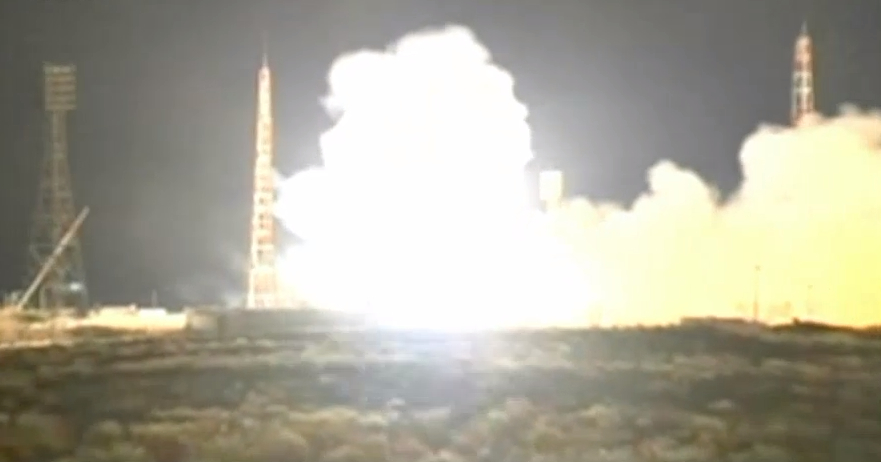Russia Launches Robotic Supply Ship to Space Station

A Russian Soyuz rocket launched an unmanned cargo freighter to the International Space Station Monday (Feb. 11) to deliver nearly 3 tons of fresh food, water and equipment to the six men living on the orbiting outpost.
The robotic Progress 50 resupply ship and its Soyuz rocket lifted off at 9:41 a.m. EST (1441 GMT) from the Central Asian spaceport of Baikonur Cosmodrome, where it was late evening local time at the time of launch.
The Progress 50 cargo ship is flying on an accelerated schedule that will deliver it to the International Space Station in six hours, instead of the two days the unmanned cargo trips have traditionally taken for much of the space station's 13 years of crewed operation. Progress 50 is expected to arrive at the space station at 3:40 p.m. EST (2040 GMT) and park itself at a Russian docking port.
You can watch the Progress 50 dock live on SPACE.com here, beginning at 3 p.m. EST (2000 GMT), courtesy of NASA's television feed. Prior to the space docking, you can watch NASA launch the new Landsat Earth-observation satellite live at 1:02 p.m. EST (1802 GMT). The webcast for that launch begins at 10 a.m. EST (1500 GMT).
The Progress 50 spacecraft is packed with about 2.9 tons of supplies for the space station's six-man Expedition 34 crew. On Saturday, the station astronauts discarded an older unmanned cargo ship —called Progress 48 —in order to make room for Progress 50. The outgoing Progress vehicle was filled with tons of trash and unneeded items and intentionally destroyed by burning up in Earth's atmosphere. [Space Station's Robot Cargo Ship Fleet (Photos)]
Progress 50, meanwhile, is delivering about 764 pounds (346 kilograms) of propellant, 110 pounds (50 kg) of oxygen and air, 926 pounds (420 kg) of water and about 3,000 pounds (1,360 kg) of spare parts, science gear and other supplies, according to a NASA description.
The Russian Federal Space Agency's Progress spacecraft are disposable vehicles similar in design to its three-segment Soyuz crew capsules, but with a propellant module in place of the central crew return capsule on the Soyuz.
Get the Space.com Newsletter
Breaking space news, the latest updates on rocket launches, skywatching events and more!
Progress vehicles are designed to be disposable and are intentionally destroyed by burning up in Earth's atmosphere at the end of their mission. Robotic resupply ships for the station built by Europe and Japan are also disposed of in the same way.
The only robotic supply ship for the space station that can return supplies back to Earth is the Dragon space capsule built by the private spaceflight company SpaceX. Dragon space capsules visited the space station twice in 2012, with the next one slated to launch from Florida atop SpaceX's Falcon 9 rocket in March. Dragon vehicles are equipped with a heat shield to protect them during re-entry and are built for ocean splashdown landings in order to return experiments and other gear to Earth.
You can follow SPACE.com Managing Editor Tariq Malik on Twitter @tariqjmalik. Follow SPACE.com on Twitter @Spacedotcom. We're also on Facebook & Google+.
Join our Space Forums to keep talking space on the latest missions, night sky and more! And if you have a news tip, correction or comment, let us know at: community@space.com.

Tariq is the Editor-in-Chief of Space.com and joined the team in 2001, first as an intern and staff writer, and later as an editor. He covers human spaceflight, exploration and space science, as well as skywatching and entertainment. He became Space.com's Managing Editor in 2009 and Editor-in-Chief in 2019. Before joining Space.com, Tariq was a staff reporter for The Los Angeles Times covering education and city beats in La Habra, Fullerton and Huntington Beach. In October 2022, Tariq received the Harry Kolcum Award for excellence in space reporting from the National Space Club Florida Committee. He is also an Eagle Scout (yes, he has the Space Exploration merit badge) and went to Space Camp four times as a kid and a fifth time as an adult. He has journalism degrees from the University of Southern California and New York University. You can find Tariq at Space.com and as the co-host to the This Week In Space podcast with space historian Rod Pyle on the TWiT network. To see his latest project, you can follow Tariq on Twitter @tariqjmalik.









